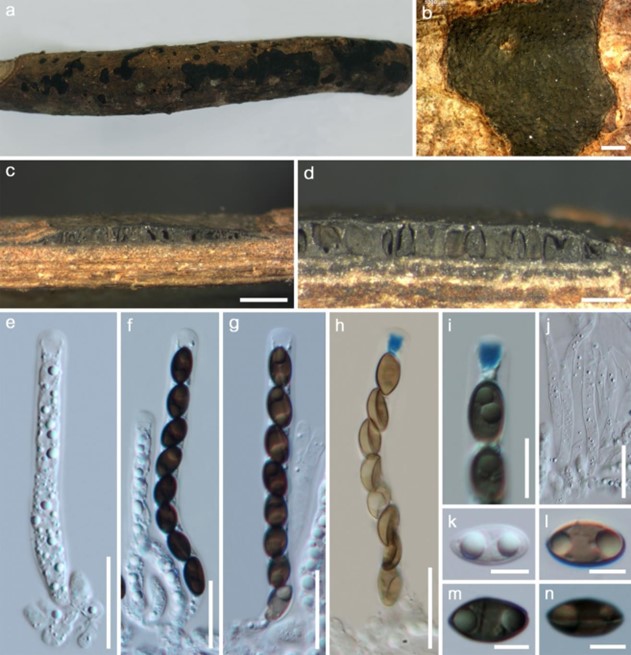Biscogniauxia mangiferae Samarak. & K.D. Hyde, in Hyde et al., Mycosphere 11(1): 611 (2020)
Index Fungorum number: IF 556894; MycoBank number: MB 556894; Facesoffungi number: FoF 06780;
Etymology – Named after the host genus on which the fungus occurs.
Holotype – MFLU 18–0827.
Saprobic on dead branch of Mangifera indica L. (Anacardiaceae). Sexual morph: Stromata 0.5–3.5 cm long, 0.25–1.5 cm width, applanate, dull brown to black, carbonaceous. Perithecia 185– 225 μm (x̅ = 205 μm) diam., 310–430 μm (x̅ = 360 μm) high, ovoid to obpyriform, laterally compressed. Ostiole pointed, raised. Paraphyses 3.9–6.5 μm (x̅ = 5.4 μm, n = 20) wide, hyaline, septate, round apex, guttulate. Asci 80.7–94.4 × 6.7–8.6 μm (x̅ = 88.6 × 7.8 μm, n = 25), 8-spored, unitunicate, cylindrical, pedicellate, with J+, apical ring bluing in Melzer’s reagent, wedge-shaped with 2.6–5 μm (x̅ = 4.1 μm, n = 25) high, 2.5–3.7 μm (x̅ = 3.1 μm, n = 25) broad. Ascospores 8.8– 11.7 × 5.3–6.5 μm (x̅ = 10.3 × 6 μm, n = 35), uniseriate, unicellular, ellipsoid, rounded ends, dark brown to black at mature, smooth, with straight germ slit spore-length. Asexual morph: Undetermined.
Material examined – Thailand, Doi Phu Kha, Naan 55000, dead branch of Mangifera indica (Anacardiaceae), 4 August 2017, M.C. Samarakoon, SAMC049 (MFLU 18-0827, holotype); ibid. (HKAS 102330, isotype).
GenBank numbers – ITS: MN337232, LSU: MN336236, rpb2: MN366247, tub2: MN509782.
Notes – Biscogniauxia nummularia (type species), B. capnodes, B. petrensis and the strain isolated in this study clustered with high statistical support (98% ML). Our strain is sister to B. petrensis (100% ML). Biscogniauxia petrensis was described by Zhang et al. (2017c) from a karst cave ecosystem with its asexual morph. Morphological comparisons are not possible and ITS comparison shows 5.7% bp differences among these two strains. Biscogniauxia capnodes differs from our strain by its obovoid to tubular perithecia, discoid apical ring and large ascospores. Biscogniauxia reticulospora described from undetermined corticated wood (Thailand) differs from our strain by its comparatively larger ascospores (27–34 × 14–15.5 μm) with ornamentations and reticulations (Ju & Rogers 2001), as compared to ascospores in our strain (8.8–11.7 × 5.3–6.5 μm).

Figure 1 – Biscogniauxia mangiferae (MFLU 18-0827, holotype). a, b Stroma on the host. c, d Cross section of stromata showing the ascoma and ostiole. e-g Asci. h, i J+, apical ring in Melzer’s reagent. j Paraphyses. k-n Ascospores. Scale bars: b, c = 1000 μm, d = 500 μm, e-h = 20 μm, i, j = 10 μm, k-n = 10 μm.
